 |
|

|
 |
TABLE of CONTENTS
 |
Maintenance crews to test rubber plow blades, colored salt in annual winter battle |
By Kevin Gutknecht
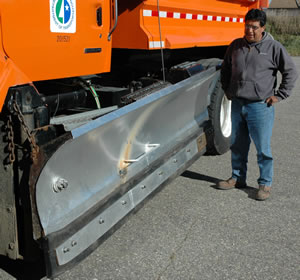
Lenny Garcia, transportation generalist, Lakeville truck station, stands next to a plow with a rubber blade installed on it. Photo by Kevin Gutknecht |
In an ongoing effort to make removal of snow and ice from state roads more efficient and effective, Mn/DOT snowplow operators statewide are trying out several new methods this year.
Norm Ashfeld, Metro Maintenance, said the Metro District will test a rubber plow blade.
“We are trying to figure out a way to be kinder to pavement markings,” he said. “We will test these on a couple trucks at the Lakeville station. We want to see if the plows are durable and if they cause less wear on road striping.”
The non-metal plow blades, manufactured in Pennsylvania, are made of a very hard and durable rubber and are twice as thick as the carbide steel blades. They perform like a regular blade, Ashfeld said, and at a cost of $300, they are less than half the price of a $650 steel blade. He added that this type of blade has been used primarily for clearing parking garages and other smaller tasks.
The blade’s effect on striping will be tested on three roads with identical pavement markings. The rubber blades will be used on Interstate 35, while steel will be used on Hwy 5 and Hwy 280. Maintenance will test the reflectivity of the pavement markings on these roads this fall, and again next spring to determine how much wear has occurred.
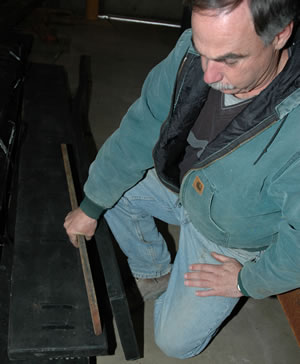
Cliff Gergen, a maintenance supervisor at the Lakeville truck station, displays two types of plow blades. In his hand is the steel blade; the new rubber-tipped blade is in black. Photo by Kevin Gutknecht |
Another tool the Metro District will test this year is a zero-velocity salt and sand spreader. Ashfeld said the concept is that the material comes out of the spreader on the back of a plow truck at the same speed as the truck is moving.
“The material should drop straight down to the road and not get spread out of the road and onto the shoulders,” he said.
Truck operators and maintenance supervisors will evaluate the effectiveness of the spreader this winter and compare it to the standard spreaders. Ashfeld said Maintenance will also determine how durable the spreader is. An earlier version has been used in the past, and it did not hold up well. The new spreader will be used on one truck, also from the Lakeville truck station.
District 6 maintenance crews will test the effectiveness of using pre-wetting methods on sand and salt on a section of I-90. The district will also use colored salt—violet and green—from two of its truck stations to see if operators can better see the application and not reapply materials to an area that has already been done. Maintenance will also install heaters for windshield washer fluid on six trucks to test their effectiveness at providing better visibility.
In District 3, crews will also test the effectiveness of pre-wetting methods on four different routes. The district also is considering using colored salt to assist in efficient material use.
|
 |
|

|
 |
TABLE of CONTENTS
 |
Hwy 36 reconstruction project wins federal grant |
By Donna Lindberg
Mn/DOT recently received a $1 million Highways for LIFE grant from the Federal Highway Administration for next year’s project to reconstruct Hwy 36 between White Bear Avenue and Hwy 120 in North St. Paul. The Highways for LIFE grant is awarded to state transportation agencies that use innovative technologies, manufacturing processes or contracting practices that improve safety and highway quality and help reduce congestion.
An innovative contracting method used on the project will be to close Hwy 36 during construction.
“Mn/DOT has not fully closed a major freeway for construction in 16 years,” said Chris Roy, Metro District north area manager. “Not having to work around traffic will allow us to complete work 60 to 75 percent faster, reduce construction costs and minimize safety hazards.”
Innovative technologies that will be used include intelligent compaction equipment that adjusts compaction effort of grading machines and portable, light-weight deflectometers that measure compaction of the road bed.
“Mn/DOT’s use of these emerging technologies will result in more efficient use of resources and a higher quality, more uniformly compacted surface,” said Tom Ravn, innovative contracting director.
The $22 million Hwy 36 project is scheduled to begin in February 2007. The roadway will be closed approximately from mid-April to mid-September and then reopen to a single lane of traffic until completion in June 2008.
For more information about the Hwy 36 reconstruction project, go to http://www.dot.state.mn.us/metro/projects/th36/index.html.
|
 |
|

|
 |
TABLE of CONTENTS
 |
Successful pilot spurs departmentwide installation of new phone system |
|
By Kevin Gutknecht
After a successful test run in several offices and in District 3, a new phone system that allows users to make telephone calls over a computer data network will be installed departmentwide as a way to save money and provide better phone service, said Bob Bennett, Office of Information Technology.
Bennett expects to have new phones installed at all Central Office sites by March 2007, and at all district offices by October 2007.
“The voice over internet protocol phone system has performed better than expected in District 3,” he said. “Since the installation was complete there in June, the district has seen a 64 percent cost savings on monthly phone bills.”
During the test phase, Bennett said some misconceptions about the VOIP system have come up.
“The phone signal is carried on a secure state network, not on the public Internet,” he said. “And the VOIP system has direct connections to the traditional phone telephone network so that it has the same or better level of 911 service as non-VOIP phone systems."
The installation will include training and support, said Vicky Sarner, OIT, who is the project manager for the effort.
“There will be a key expert in each office who will be trained on the phone system,” she said. “We will run training classes Monday through Thursdays, and Fridays will be an open lab for those who want to come in and learn more about the phone. There is also an online e-learning tool available.”
In the Central Office, the training and phone lab will be in G-14. Sarner said the key experts will manage the training for their offices and will pre-register employees for phone training.
The tentative schedule for the Central Office installation is:
Location |
Date |
Information Technology |
30-Oct-06 |
Civil Rights & Administrative Services |
6-Nov-06 |
Land Management |
29-Jan-07 |
Homeland Security |
29-Jan-07 |
Environmental Services |
5-Feb-07 |
State Aid |
5-Feb-07 |
Audit |
5-Feb-07 |
Technical Support |
12-Feb-07 |
Human Resources |
19-Feb-07 |
Affirmative Action |
19-Feb-07 |
Finance |
19-Feb-07 |
Freight & Commercial Vehicles |
26-Feb-07 |
Construction |
5-Mar-07 |
Maintenance |
5-Mar-07 |
Traffic, Data & Analysis |
12-Mar-07 |
Investment Management |
12-Mar-07 |
Transit |
12-Mar-07 |
Communication |
19-Mar-07 |
Commissioner Area |
19-Mar-07 |
For more information:
|
 |
|

|
 |
TABLE of CONTENTS
 |
Tribes & Transportation Conference focuses on safety |
|
By Kay Korsgaard
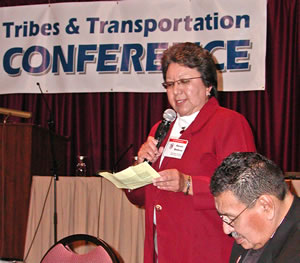
Karen Bedeau, District 2 public affairs coordinator, introduces a speaker at the Tribes and Transportation Conference held in October. Photo by John Bray |
According to the National Highway Traffic Safety Administration, 5,962 fatal motor vehicle crashes occurred on roads under the jurisdiction of Indian reservations between 1975 and 2002—an average of 213 fatal crashes per year.
“That’s why when planning began for the 2006 Tribes and Transportation Conference, safety quickly became the focus,” says Linda Aitken, tribal liaison.
The conference focused on the “Four E’s”—enforcement, engineering, emergency medical care and education—identified in the state’s Comprehensive Highway Safety Plan as necessary to help reduce serious injuries and fatalities on Minnesota roadways.
The 2006 conference marks the fifth year that representatives from federal, state, city, county and tribal government have gathered to share information and forge partnerships to make Minnesota’s transportation system work better.
|
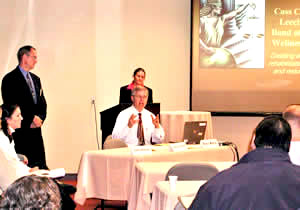
Reno Wells, Cass County probation officer, center; Judge John P. Smith, ninth Judicial District, Cass County, left; and Judge Korey Wahwassuck, Leech Lake Tribal Court, discussed a collaborative initiative by Cass County and the Leech Lake Band of Ojibwe to establish a wellness court to treat and heal members of their community with violations of Minnesota’s Impaired Driving Code. Photo by John Bray |
“This year’s focus on safety brought in a new partner—the Department of Public Safety,” said Karen Bedeau, District 2 public affairs coordinator and one of the conference planners.
“One of the objectives of the conference was to find ways to form partnerships to better utilize resources,” she said. ”The breakouts allowed many opportunities for people to meet each other and find opportunities for partnerships.”
One example occurred in a breakout session about emergency medical services.
“An audience member was able to offer information to the presenters about possible grant funds that their organizations could apply for,” she said.
In keeping with the safety theme, several presentations focused on driver behavior–especially seatbelt use and driving while intoxicated among Native Americans–and ways to use the court system and education to provide remedies.
“Native Americans killed in motor vehicle crashes are more often driving while intoxicated, less validly licensed and less likely to be wearing a seat belt than the general population,” according to Cheryl Cloud, program manager for the Michigan Tribal Technical Assistance Program. |
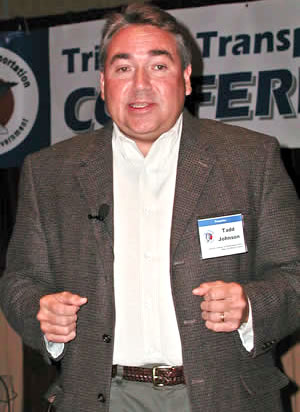
Tadd Johnson, Mille Lacs Band of Ojibwe, discussed tribal sovereignty and the history of federal Indian policy. Photo by John Bray |
“I see great value in this conference and the partnerships that are coming out of it,” said Dan Brannan, traffic safety specialist. Brannan led a breakout session on speed limits, how they are determined and the process local governments should follow to study an existing limit.
“This is a group of people and a group of highways where there are great opportunities to improve safety,” said Brannan. “Recent decisions at the federal level give tribes power to identify and resolve problems on the reservation at the tribal level. The idea that tribes can determine where their safety funds should be spent is a landmark to them.”
“Hopefully,” he said, “with the partnerships we are forming we can better work with the tribes to help them improve safety in targeted areas.”
Aitken said that conference notes and a summary will be posted on the Tribes and Transportation Web site.
“We will also be looking at the conference evaluations to help start planning for next year,” she said.
Related links:
|
 |
|

|
 |
TABLE of CONTENTS
 |
Advocacy Council for Tribal Transportation improves decision making |
By Kay Korsgaard
The Advocacy Council for Tribal Transportation was recently established at the urging of Melanie Benjamin, Mille Lacs Band of Ojibwe chief executive, to discuss roadway policy and devise a cohesive plan for roadways on or near Indian reservations.
“Transportation is a critical issue to Minnesota tribes,” said Linda Aitken, tribal liaison. “Highway and local road systems connect tribal members with businesses, education, heath care and recreation.
“Today, many of the tribes have contracted or formed a compact with the Indian Reservation Roads program from the Bureau of Indian Affairs and provide total or partial transportation responsibilities for IRR roads owned by the tribe. With the SAFETEA-LU federal transportation bill, IRR funding is now available for tribes directly from Federal Highway Administration.
“That makes communication among road jurisdictions, including tribes, local government, Mn/DOT and the FHWA critical to ensure the development of reservation transportation systems that are efficient, safe and meet the needs of our tribal members and the traveling public,” Aitken said.
The ACTT members include representatives from 11 Minnesota tribes, Mn/DOT District 1 and District 8 engineers Mike Robinson and Dave Trooien, representatives from the FHWA, Bureau of Indian Affairs, the Michigan Tribal Technical Assistance Program, Minnesota Indian Affairs Council and counties and cities.
“The first meeting was held in September, and it was a great success,” Aitken said.
“We had good discussions and groups were formed to start working on specific issues. At the first meeting we discussed tribal road signs and roadside vegetation,” she said.
Burny Tibbetts, transportation director for White Earth and ACTT co-chair, agreed.
“We are starting to create the partnerships we need to make progress,” he said, citing an example close to home. “White Earth has our own sign truck–but in the past the county has wanted to make our signs and charge us for them. With the partnerships we are forming we can start to resolve some of these issues.”
More information about the advocacy council, including meeting minutes and council members is available on the Web at www.dot.state.mn.us/mntribes/actt.
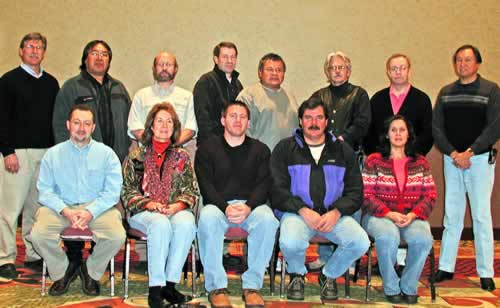
Seated: Tom Sorel, FHWA; Linda Aitken, Mn/DOT; Mike Moilanen, Mille Lacs Band of Ojibwe and ACTT co-chair; Burny Tibbetts, White Earth Band of Ojibwe, ACTT co-chair; Cheryl Cloud, Michigan Tribal Transportation Technical Assistance Program. Top row: Mike Robinson, Mn/DOT; Donald Mays, Red Lake Band of Chippewa; Jim Walker, Red Lake Band of Chippewa; Marc Mogan, Prairie Island Indian Community; Lester Morris, Shakopee Mdewakanton Sioux Community; Dave Danz, Grand Portage; Dave Trooien, Mn/DOT; Jody Goodthunder, Lower Sioux Community. Photo by John Bray |
|
 |
|

|
 |
TABLE of CONTENTS
 |
CTS panel to discuss economic issues facing an aging interstate system |
|
The Center for Transportation Studies, Hubert Humphrey Institute of Public Affairs, Mn/DOT and the Federal Highway Administration will host a roundtable discussion Nov. 29 on the policy questions facing the nation’s 50-year-old interstate system during the 21st century.
“At 50: Economic Issues Facing an Aging Interstate System” will feature Dan McNichol, a best-selling author and nationally recognized expert on the interstate system. He will be joined by a panel of speakers representing federal, state and private sector interests that will address the policy questions affecting national, regional and local interests during the next 50 years.
The roundtable is one in a series of events that Minnesota is celebrating to observing the 50th anniversary of the signing of the Federal Highway Act of 1956, the legislation that put construction of the U.S. interstate system into motion.
The event will be held at the McNamara Alumni Center on the University of Minnesota campus from 8 to 11 a.m. There is no cost, but participants are asked to register because space is limited.
For more information, see www.cts.umn.edu/events.
|
 |
|

|
 |
TABLE of CONTENTS
 |
Metro District’s Joella Givens earns leadership award |
 Joella Givens
Photo by Teresa Callies |
Joella Givens, a Metro District GIS manager, received the Polaris Leadership Award from the Minnesota GIS/LIS Consortium Oct. 5.
The consortium’s annual award is presented to mid-career professionals who have shown leadership and provided inspiration to others in the geographic and land information systems field.
The award cites Givens’ accomplishments since joining Mn/DOT in 1997.
For more information about Givens’ award, see Metro District’s employee newsletter, August 2006.
|
 |
|

|
 |
TABLE of CONTENTS
 |
Open enrollment 2007 will be held from Nov. 1-14 |
|
Your opportunity to make insurance benefit selections for 2007 is available now through Nov. 14 as part of the State Employee Group Insurance Plan annual open enrollment period.
Choices available to state employees this year include:
- Changing health carriers
- Adding or dropping dependents
- Enrolling in the 2007 pre-tax accounts (Dependent Care Expense Account, the Medical/Dental Expense Account or the Transit Expense Account)
- Enrolling in or adding to long-term disability insurance
- Changing the disability elimination period in the Managers Income Protection Plan (for managers only)
A new feature this year is the addition of a link from each clinic directly to the MN Community Measurement, which allows employees to compare both cost and quality when considering choices for a health care clinic.
Like last year, a health care assessment is being offered for employees to learn about personal health and to connect with resources to help improve their health. Completing this optional survey will entitle participants to receive a $5 reduction on office copays for both themselves and their dependents. Even if you took the health assessment last year, you must take it again to receive the lower copayment in 2007.
Find more information on the Department of Employee Relations Web site:
Questions can be directed to the Office of Human Resources or to the SEGIP service center at 651/355-0100.
|
 |
|

|
 |
TABLE of CONTENTS
 |
Fate, circumstances play out in history of the interstate system |
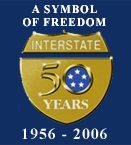
Mn/DOT's Web site has a whole section devoted to the history and stories of the interstate highway system. |
The October article on Mn/DOT’s Web page dedicated to the 50th anniversary of the interstate highway system describes how the whims of fate and building and maintaining the system affected Mn/DOT employees’ lives and careers.
A few employees narrowly escaped death or serious injury. Others, sadly, died.
The scope of the project and the wide range of skills needed to design, build and maintain the freeway system drew many workers to Mn/DOT.
Engineering schools and construction firms provided people who already had transportation careers in mind, while many seized the opportunity for well-paying jobs.
Others seemed pre-destined for careers in transportation by their strong interest in the field.
To read some of their stories, visit the 50th anniversary site: www.dot.state.mn.us/interstate50/.
If you have a story to share about your experiences on the interstate system, please contact Craig Wilkins, Office of Communications, by e-mail or calling 651/296-0838.
|
 |
|

|
 |
TABLE of CONTENTS
 |
ROC 52 design-build reconstruction project breaks new ground as award winner |
By Donna Lindberg
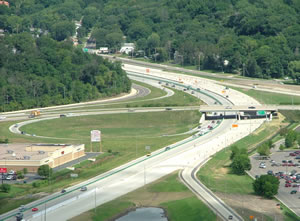
Since it began in 2002, the Hwy 52 design-build project has been repeatedly recognized by the transportation construction industry. Most recently, the project won a merit award from the Design Build Institute of America for "breaking new ground" in the area of project delivery. Photo courtesy of Terry Ward |
One year after celebrating completion of Highway “ROC” 52 reconstruction project through Rochester, Mn/DOT’s first design-build/best-value project is still receiving attention.
“The ROC 52 project represents a new way of delivering projects for the department,” said Terry L. Ward, ROC 52 project manager. “Also, the efforts of everyone involved resulted in a high-quality project, delivered ahead of schedule, with minimal cost growth and with overwhelming public support.”
The project recently won a merit award from the Design Build Institute of America for “breaking new ground” in the area of project delivery. This award, in the over $50 million category, was presented jointly to Mn/DOT, Zumbro River Constructors, Progressive Construction, Inc. and URS Corporation.
“ROC 52 had to compete against other mega design-build projects across the county for this award,” said Jay Hietpas, design-build program manager. “Winning this award is a great accomplishment for both Mn/DOT and the design-build team.”
Since the project began in 2002, it has been repeatedly recognized by the transportation construction industry.
“The design-build/best-value approach aligned our project goals with both our local and industry partners, which led to its success,” Ward said. “It also forced us to look critically at what we do and to adopt a more performance-based contracting approach.”
The project was a 2005 runner-up for the State Governments Innovations award from the Council of State Governments, Midwest chapter. It was also named National Project of the Year in 2005 by the American Public Works Associations for projects over $100 million. It has won awards from both the Minnesota and National Concrete Paving Associations. And in 2002, it received an Environmental and Enhancement award from the Rochester Committee on Urban Design.
For more information about the ROC 52 and other design-build projects in Minnesota, go to http://www.dot.state.mn.us/designbuild/. |
 |
|

|
 |
TABLE of CONTENTS
 |
Mn/DOT earns honors for bridge preservation plan, Hwy 61 bridge restoration in Duluth |
By Craig Wilkins
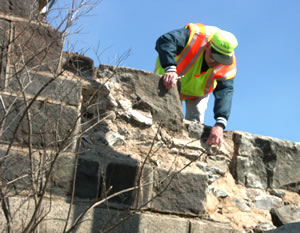
Arlen Ottman, Bridge Office, inspects damage on the Hwy 61 bridge on April 15, 2005. Photo by Bob Hawkinson |
The Preservation Alliance of Minnesota honored Mn/DOT for its restoration of the historic Hwy 61 bridge over the Lester River in Duluth and for its plan to preserve other historic bridges in the state.
The association cited Mn/DOT’s careful, detailed restoration work when repairing the bridge after it was damaged by a semitrailer last year.
The arched, concrete and masonry bridge was originally built in 1928. The bridge carries Hwy 61 over the Lester River where it enters Lake Superior.
Arlen Ottman, a design unit leader with the Bridge Office, said the effort involved his office, the Cultural Resources Unit, Duluth/District 1 and the State Historical Preservation Office.
The work included installing a new concrete railing that meets current safety standards and covering it with a veneer cut from rocks knocked into the riverbed by the crash. The project also included recovering pieces of granite that covered the railing before the incident and re-using them as well.
The contractor also repaired the sidewalk during the restoration work.
Kristen Zschomler, a historian and archeologist with the Cultural Resources Unit, said the project earned an excellence in highway design award in the historic preservation category.
That award, she said, is based on the restoration work and how well the refurbished structure matches the bridge’s original design while maintaining current safety standards.
The Preservation Alliance of Minnesota announced Mn/DOT’s award in concert with its annual list of structures cited for restoration or reuse.
The Lester River bridge is one of 24 historic bridges included in Mn/DOT’s restoration plan.
This year’s award is the second Mn/DOT has received from the association.(See also “Inventory of roadside structures earns preservation award” (Mn/DOT Newsline, Nov. 7, 2001).
|
Before. . .
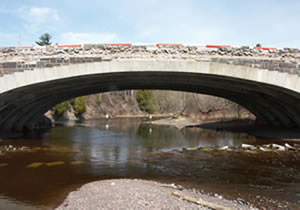
The arched, concrete and masonry Hwy 61 bridge over the Lester River in Duluth suffered damaged from a semitrailer last year. Photo by Bob Hawkinson |
. . .And after 
Mn/DOT’s careful, detailed restoration work earned honors by the Preservation Alliance of Minnesota. |
|
 |
|

|
 |
TABLE of CONTENTS
 |
Transportation amendment: an opportunity Minnesota can’t afford to miss |
By Lt. Gov. Carol Molnau, commissioner of transportation
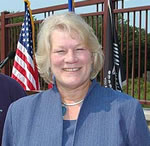
Lt. Gov. Carol Molnau
Photo by David Gonzalez |
Next Tuesday, Minnesota voters will have the opportunity to vote on a constitutional amendment that would dedicate all revenues from the state’s motor vehicle sales taxes to transportation. If enough voters mark “yes” on their ballots, an additional $300 million annually will go toward state highways, local roads and transit statewide by 2012.
You’ve more than likely seen or read ads and articles both for and against this amendment in the newspaper, on television and radio, and along the roadside.
I would be remiss if I didn’t let you know how important I think this amendment is to the future of our state transportation system.
We’ve made great progress over the last four years to meet Minnesota’s transportation needs, thanks to your hard work. But we’re in danger of losing this momentum if a new, long-term funding source cannot be found. Though the new funds that would be generated from the amendment won’t solve all the state’s transportation funding needs, they would represent a significant step in the right direction.
I have been actively promoting the passage of this amendment during all my travels and speeches around the state over the past several months. The amendment simply takes the motor vehicle sales taxes we already pay and directs them to transportation where they belong. It’s just common sense—transportation revenue should go to transportation projects.
The percentage dedicated to transportation can—and has—changed at the whim of the Legislature. During most of the 1990s, for example, the amount going to transportation was zero. Without a constitutional dedication, motor vehicle sales taxes cannot be counted on as a long-term revenue stream for transportation. Currently, state law directs only 54 percent of the motor vehicle taxes to transportation, with the remainder used in the general fund.
It is important to understand that no cuts in general fund programs are necessary, projected or anticipated if the constitutional amendment passes. The new money directed to transportation will be more than covered by projected growth in general fund revenues.
A proposed constitutional amendment is sometimes the least exciting and the least understood part of an election ballot. However, in the case of amendments, if folks ignore it all together, it’s just as if they voted “no.” If you support the amendment, you must be sure to cast a “yes” vote.
I hope that, as good citizens, you will all get out and vote on Nov. 7.
I also encourage you to vote “yes” on the constitutional amendment. It’s a transportation opportunity Minnesota can’t afford to miss.
If you want to know more about the amendment and how a change to Minnesota’s constitution takes place, please look at our Web site at: http://www.dot.state.mn.us/information/mvst/index.html.
|
 |
|

|
 |
TABLE of CONTENTS
 |
To ALL the workers who were involved in the construction work along I-494... |
|
A note from a happy motorist traveling on Interstate 494:
I would like to commend all who worked on the planning as well as the physical reconstruction project of Interstate 494 between Hwy 62 and Hwy 394...You all did a FANTASTIC job on the merge lanes on and off I-494, as well as PRESERVING the natural beauty on that stretch of highway...we have so little of it left anymore.
This kind of work should be set as a model for future reconstruction projects!!!
I hope that all of you give yourselves a double pat on the back for this one...GREAT JOB!!!!!
Very, very pleased taxpayer and citizen.
Pam Bassett, Wayzata, Minn.
Editor’s note: For more information about the project, see “Ceremonies, speeches mark completion of rebuilt I-494 section,” (Mn/DOT Newsline, Sept. 6, 2006).
|
 |
|
| |
|



